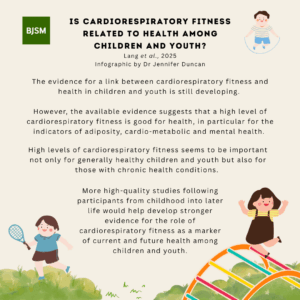Keywords: Cardiorespiratory fitness, health outcomes, youth, clinical
This blog provides a summary of a recent study published in BJSM (1).
What is cardiorespiratory fitness?
Cardiorespiratory fitness, also called aerobic fitness, represents the ability of the heart, lungs, and blood vessels to work together to supply oxygen to muscles during prolonged physical activity. It is influenced by factors we cannot change, such as age and sex, but also by factors we can control, such as regular physical activity. Regardless of a person’s genetics or ability, regular physical activity is crucial for maintaining and improving cardiorespiratory fitness.
Why is this study important?
In recent decades, cardiorespiratory fitness has gained interest from the scientific community, with research demonstrating the benefits of high cardiorespiratory fitness for health from a young age (2). The measurement of cardiorespiratory fitness in clinical settings has been described as both important and feasible (3, 4). Surveillance of cardiorespiratory fitness from childhood may provide valuable information about the activity levels of the population, information that can help guide public health action (5). This study explores the scope of health status indicators related to cardiorespiratory fitness in all groups of children and youth, regardless of their pre-existing health status. This study helps provide a full picture of the current scientific evidence. It is key to highlight the potential of cardiorespiratory fitness as a marker of health in order to guide future research directions, and its use in clinical practice, health education, and public health.
How did the study go about this?
This study was an international effort by researchers from Australia, Canada, Spain, and the United States of America. It is part of a larger project looking at cardiorespiratory fitness and health across the lifespan. This study focused on children and youth. A sibling study explored the data for adults, which was recently published in the British Journal of Sports Medicine (6).
We used an “overview of reviews” approach to summarize currently available evidence from systematic reviews that included a meta-analysis. This systematic approach allowed us to assess a wide range of health status indicators across both general and clinical populations of children and youth. We summarized findings from 14 systematic reviews with meta-analyses, which together combined data from over 125,000 observations and covered over 30 health status indicators. We also evaluated the certainty of evidence for each health indicator and identified what kind of research is still missing.
What did the study find?
In general populations of children and youth, individuals with higher cardiorespiratory fitness levels generally had better health status, including indicators of cardiometabolic and vascular health, adiposity, mental health and well-being. We also found that apparently healthy children had higher levels of cardiorespiratory fitness when compared to their peers with a chronic condition, such as congenital heart disease, type 1 and type 2 diabetes, juvenile idiopathic arthritis, human immunodeficiency virus infection, and newly diagnosed cancer. Among patients with cystic fibrosis, those with higher cardiorespiratory fitness had a lower risk of death compared to patients with lower cardiorespiratory fitness levels.
There are still several gaps in the scientific evidence, such as limited longitudinal studies that measure cardiorespiratory fitness during childhood with follow-ups into adulthood to help establish potential causal pathways. There is also a lack of evidence looking at the relationship between cardiorespiratory fitness and important pediatric conditions such as asthma, anxiety, depression, mood disorders, developmental disabilities, autism spectrum disorder, attention-deficit/hyperactivity disorder. Furthermore, there was a lack of high quality evidence for metabolic syndrome and diabetes, representing major gaps in the literature.
What are the key take-home points?
The evidence for a link between cardiorespiratory fitness and health in children and youth is still developing. However, the available evidence suggests that a high level of cardiorespiratory fitness is good health, in particular for the indicators of adiposity, cardio-metabolic and mental health. High levels of cardiorespiratory fitness seems to be important not only for generally healthy children and youth but also for those with chronic health conditions. More high-quality studies following participants from childhood into later life would help develop stronger evidence for the role of cardiorespiratory fitness as a marker of current and future health among children and youth.

Authors: Iryna Demchenko and Justin J. Lang
References:
- Ortega FB, Ruiz JR, Castillo MJ, Sjöström M. Physical fitness in childhood and adolescence: a powerful marker of health. Int J Obes. 2008 Jan;32(1):1–11.
- Ross R, Blair SN, Arena R, Church TS, Després JP, Franklin BA, et al. Importance of Assessing Cardiorespiratory Fitness in Clinical Practice: A Case for Fitness as a Clinical Vital Sign: A Scientific Statement From the American Heart Association. Circulation. 2016 Dec 13;134(24):e653–99.
- Raghuveer G, Hartz J, Lubans D, Takken T, Wiltz J, Mietus-Snyder M, et al. Cardiorespiratory Fitness in Youth – An Important Marker of Health: A Scientific Statement From the American Heart Association. Circulation. 2020 Aug 18;142(7):e101–18.
- Lang JJ, Tomkinson GR, Janssen I, Ruiz JR, Ortega FB, Léger L, et al. Making a Case for Cardiorespiratory Fitness Surveillance Among Children and Youth. Exercise and Sport Sciences Reviews. 2018 Apr;46(2):66.
- Lang JJ, Prince SA, Merucci K, Cadenas-Sanchez C, Chaput JP, Fraser BJ, et al. Cardiorespiratory fitness is a strong and consistent predictor of morbidity and mortality among adults: an overview of meta-analyses representing over 20.9 million observations from 199 unique cohort studies. Br J Sports Med. 2024 May 2;58(10):556–66.